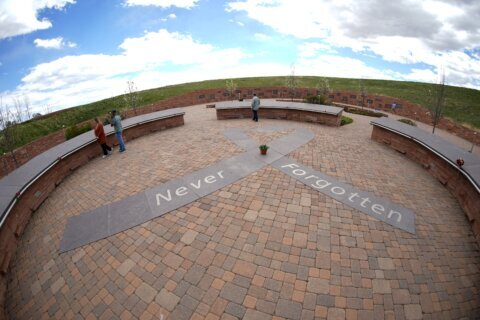The James Webb Space Telescope has provided astronomers with a glimpse of the early universe in a new image shared on Wednesday.
The powerful space observatory is capable of detecting the faint light of incredibly distant galaxies as they glow in infrared light, a wavelength that is invisible to the human eye. Webb is a crucial tool astronomers can use to better understand how galaxies formed and evolved in the early days of the universe.
The telescope captured an image of a galaxy cluster called MACS0647, as well as the distant galaxy MACS0647-JD. The cluster appears as a dazzling grouping of galaxies that seem to shine like precious gems against the dark backdrop of space.
The distant galaxy is visible because of a certain type of observational phenomenon due to the cluster. This phenomenon, called gravitational lensing, occurs when foreground galaxies act as a magnifying glass for the more distant objects behind them.
Small boxes were used to pinpoint the galaxy MACS0647-JD, and more detailed images of the galaxy are aligned along the right side of the image. The cluster essentially triple lensed the galaxy, magnifying it and causing it to appear in three separate places within the image. Each box on the right showcases different details of the galaxy.
Astronomer Dan Coe discovered MACS0647-JD 10 years ago using the Hubble Space Telescope. The new Webb image of the galaxy revealed a surprise — there are two distinct features.
“With Hubble, it was just this pale, red dot. We could tell it was really small, just a tiny galaxy in the first 400 million years of the universe,” said Coe, a Space Telescope Science Institute astronomer for the European Space Agency and Association of Universities for Research in Astronomy, in a NASA release.
“Now we look with Webb, and we’re able to resolve TWO objects! We’re actively discussing whether these are two galaxies or two clumps of stars within a galaxy. We don’t know, but these are the questions that Webb is designed to help us answer.”
The two objects differ in color, with one being more blue while the other is more red. The colors indicate different gases. While the blue object indicates the formation of young stars, the red object is dusty and older. Astronomers think that the two objects in the galaxy image may suggest that a merger between two galaxies.
“It’s really interesting that we see two structures in such a small system,” said Tiger Yu-Yang Hsiao, a doctoral student at the Johns Hopkins University, in a statement. “We might be witnessing a galaxy merger in the very early universe. If this is the most distant merger, I will be really ecstatic!”
The research team has written a paper about the discovery of the potential merger, but like so much of the first observations from Webb since it began science operations in July, the findings has not yet been through the peer review process. The team is also planning a more detailed study of MACS0647-JD in January.
Each Webb observation reveals previously hidden and unseen aspects of the universe because the telescope has the capability to spy faint infrared light through thick interstellar dust. Astronomers are excited by the telescope’s potential for discoveries because the observatory only began its estimated 20-year mission a few months ago.
“Up to this point, we haven’t really been able to study galaxies in the early universe in great detail. We had only tens of them prior to Webb,” said Rebecca Larson, National Science Foundation fellow and doctoral student at The University of Texas at Austin, in a statement. “Studying them can help us understand how they evolved into the ones like the galaxy we live in today. And also, how the universe evolved throughout time.”
The-CNN-Wire
™ & © 2022 Cable News Network, Inc., a Warner Bros. Discovery Company. All rights reserved.







